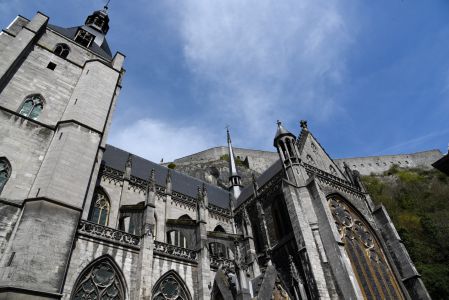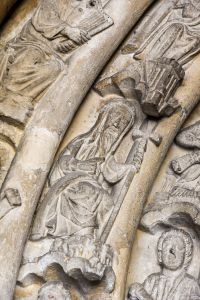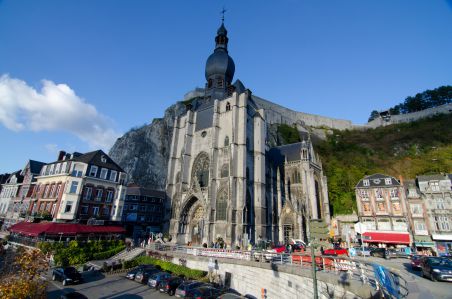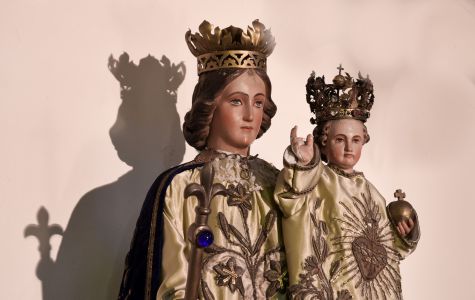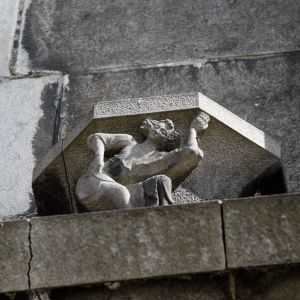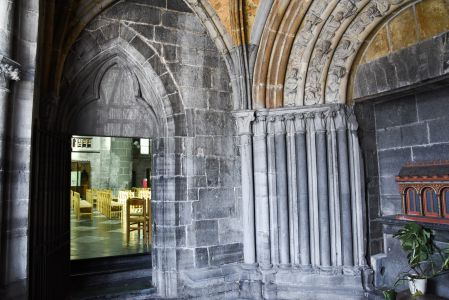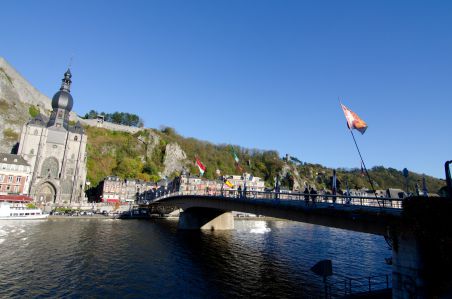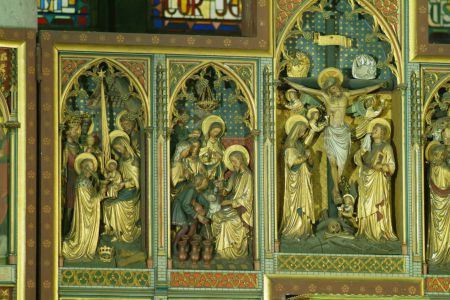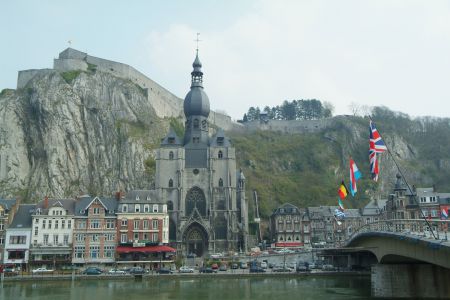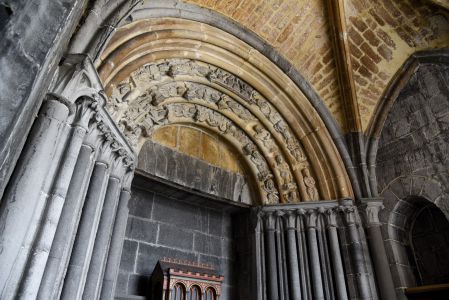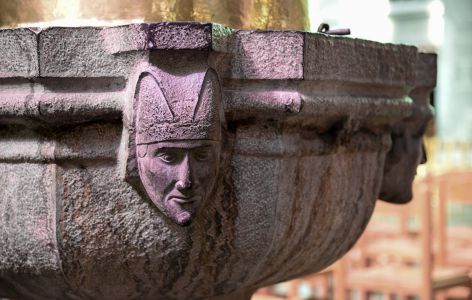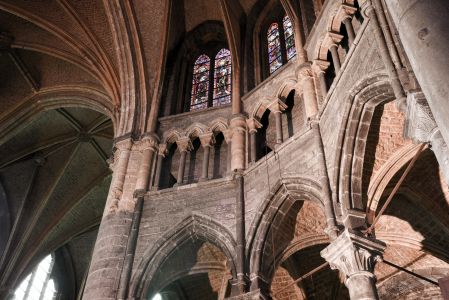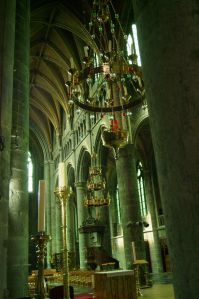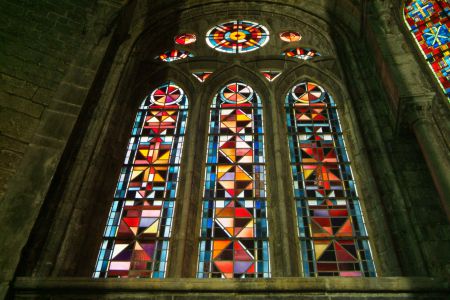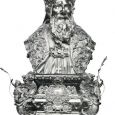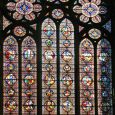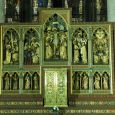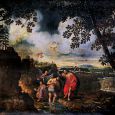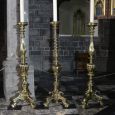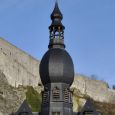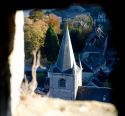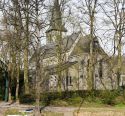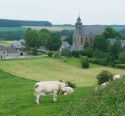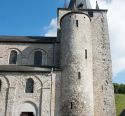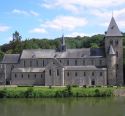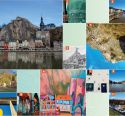Collegiate Church | XII | Gothic | Catholic Church



Map
Opening hours
01 April - 31 October
Mon 9.00 - 18.00
Tue 9.00 - 18.00
Wed 9.00 - 18.00
Thu 9.00 - 18.00
Fri 9.00 - 18.00
Sat 9.00 - 18.00
Sun 9.00 - 18.00
01 November - 31 March
Mon 9.00 - 17.00
Tue 9.00 - 17.00
Wed 9.00 - 17.00
Thu 9.00 - 17.00
Fri 9.00 - 17.00
Sat 9.00 - 17.00
Sun 9.00 - 17.00
Every Sunday in July and August : organists rehearse at 16.30.
Guided tour
Free guided visits at 15.00 hours every Sunday in July and August.
Guided visits for groups on request at the Tourist Information office +32 82 22 28 70 or at collegialededinant@skynet.be
Religious offices
Description
Next to the Meuse which overflows its banks sometimes, wedged at the foot of a rock cliff supported by steel bars and a strong net to avoid new rock falls and dominated by the citadel, the collegiate church of Notre Dame deserves credit for being there in the heart of the town despite a hostile environment and frequent attacks on it during its history.
It is a fine Gothic church with a strange onion domed belfry. At the time of its reconstruction in 1924 there was a lively discussion locally on whether or not to rebuild this belfry, constructed originally in 1566. “Yes” carried the day despite the opinions of purists who regarded the belfry as inappropriate for a Gothic building and the argument that “Dinant without the onion dome would no longer be Dinant” won.
The church portal is worth seeing and on the inside the building, in local limestone, gives an impression of majesty and creates an atmosphere for contemplation thanks to the music that is played continually.
The church also has one of the largest stained glass windows in Europe depicting the story of salvation. Other windows behind the choir recount the history of the town and the church itself.
There are some interesting religious paintings and, unexpectedly, a painting by the well known artist, Antione Wiertz from Dinant, dedicated to his parents, and titled “We will meet in heaven». There are also wooden statues of Saint Lambert and Saint Materne at the end of the church.
Photos
Media
Remarkable elements
Reliquary bust of Saint Perpetual
Remarkable piece, made by the goldsmith Philippe Lenoir from Ath in 1621 and containing the skull of Saint Perpetuus, patron of the city. Perpetuus was bishop of Maastricht. He was attached to the city of Dinant and died there in 617. He was buried in the small church of St Vincent. In the 11th century the body was moved to the collegiate church and put in a shrine that disappeared during the revolution. However, in the 17th century his head was placed in another silver relic holder that was kept out of the hands of the revolutionaries, thanks to the zeal of two inhabitants of Dinant. Until the 1960s, the bust was carried through the streets of Dinant in a procession on 15 August.
Translated with www.DeepL.com/Translator
Large stained glass window
The large church window - one of the largest in Europe, it is said - was erected in 1902 by the Ghent master Gustave Ladon. The work is inspired by the art of stained glass windows from the 13th century. Large, multi-part medallions representing the life of the Virgin and small circles representing the patriarchs, prophets and apostles alternate. This fresco is decorated with the image of the birth of the world and the coronation of the Virgin. The alternation of the narrative elements, the life of the Virgin, and the emblematic portraits are intended to inscribe the fate of Mary in the history of salvation. From the very beginning he made me (Sirach, 29,4): the Virgin is already present in God's plan.
The large altarpiece
The large altarpiece is part of the major renovations of the collegiate church in the second half of the 19th century, the aim of which was to give it its original Gothic character. Jean-Baptiste Béthune has drawn up the plan, the cut-out parts come from the Blanchaert studio in Ghent, the paintings are the work of the Liège painter Helbig. The whole takes its inspiration from the Brabant sculpted altarpieces of the 15th and 16th centuries. In any case, the liturgical evolution forces to classify, such as the insertion of the composition of the gilded tabernacle, a work by the Liège goldsmith Jules Wilmotte, into the centre.
Christ's Baptism in a Mosan landscape
This painting is the work of the painter Perpète Evrard (Dinant 1662-La Haye 1727). For the main characters, the artist interprets a painting by Pierre Mignard, painted for the church of Saint-Jean-Baptiste in Troyes. The originality of Evrard lies in the fact that he situates this episode of the Gospel in a Meuse landscape. The Christ is standing with his feet in a small tributary of the Meuse where, in the background, one can see the beautiful limestone tides. This process, common in the Baroque period, aims to clarify the sacred presence. It allows the viewer to imagine, next to a family Christ, close to man.
Dinanderie (Brassware)
Dinant owes its growth to the brass industry to which it has given its name. The collegiate church preserves some witnesses of a know-how that has been perpetuated to this day. In the choir, we can admire a 15th century lectern dish with a delicate flamboyant network. Six chandeliers are signed by active Dinant founders around 1640, their style hesitates between Renaissance and Baroque. The large paschal candlestick was made in 1880 by Victor Poncelet during the neo-Gothic transformations. Finally, we admire contemporary achievements, the altar (M-J. François, 1992) and the ambons (F. Favero, 2006) which constitute the heritage of an age-old know-how.
Bulbous bell tower
An anecdote is attached to this remarkable construction. Ordered in 1575 to be placed on the bridge, it proved too heavy and was placed on the collegiate church. In the 19th century, the sphere was taken through the mud by archaeologists and purists - Victor Hugo compared it to a water jug - or was a pleasure for romantic colourful amateur painters. On 23 August 1914, the Germans plundered the city and 624 inhabitants of Dinant merged. The sphere catches fire and collapses. His reconstruction in 1927 had a symbolic meaning. From now on, the sphere symbolises the regained honour of the inhabitants of Dinant.
Nearby
Circuit
The old stones and their treasures

Detours and other pilgrimages in Namur (loop 4) - The time machine does not yet exist. Maybe one day... In the meantime, if you want to go back a few centuries, a short walk through Bouvignes and Dinant is a must.




